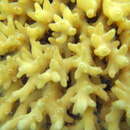en
names in breadcrumbs


Acropora caroliniana is a species of acroporid coral that was first described by Nemenzo in 1976. Found in tropical, shallow reef slopes, it occurs at depths of 5 to 25 m (16 to 82 ft) in a marine environment. The species is rated as vulnerable on the IUCN Red List, with a decreasing population. It is rare, but has been found over a large area, and two-thirds of the regions of Indonesia.
Acropora caroliniana species form in thick horizontal structures, made of flat branches.[2] It is light green,[3] pale blue or white-brown in colour, and are also found on small branchlets. These have large axial corallites with diameters up to 1.7 to 3.5 millimetres (0.067 to 0.138 in)[3] which become narrow at the ends, and curve upwards. The species' radial corallites are small and "pocket-like". It looks similar to Acropora lokani and Acropora loripes.[2][3] It is found on the upper slopes of tropical, shallow reefs, at depths of between 5 and 25 m (16 and 82 ft), and reaches maturity at over eight years.[1] The species is found at temperatures of 25.48 to 27.5 °C (77.86 to 81.50 °F).[4] Colonies have diameters of up to 50 centimetres (20 in) and branchlets can reach lengths of 25 millimetres (0.98 in) and widths of 8 millimetres (0.31 in).[3]
Acropora caroliniana is uncommon but found over a large area; Australia, western Pacific, the Indo-Pacific, Pohnpei, and Fiji in marine habitats. It occurs in two-thirds of the regions of Indonesia and also in Papua New Guinea.[1] It is threatened by the global reduction of coral reefs, the increase of temperature causing bleaching, disease, coral harvesting, climate change, fishing, human development, pollution, and being prey to starfish Acanthaster planci.[1] It is sometimes found in Marine Protected Areas. It is listed as a vulnerable species on the IUCN Red List as the population is decreasing, and is listed under Appendix II of CITES.[1]
It was first described by F. Nemenzo in 1976 in the Philippines as Acropora caroliniana.[5]
Acropora caroliniana is a species of acroporid coral that was first described by Nemenzo in 1976. Found in tropical, shallow reef slopes, it occurs at depths of 5 to 25 m (16 to 82 ft) in a marine environment. The species is rated as vulnerable on the IUCN Red List, with a decreasing population. It is rare, but has been found over a large area, and two-thirds of the regions of Indonesia.